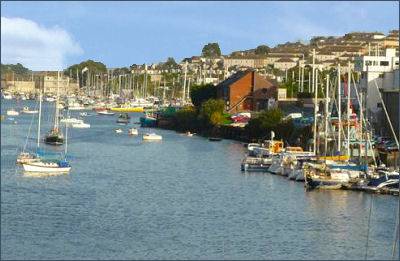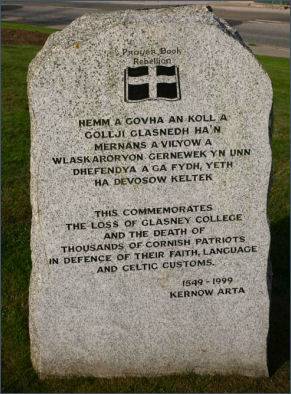OS Grid Ref:-
 The historic town of Penryn lies in a sheltered position on the Penryn River about a mile (1.6 km) to the northwest of Falmouth. The name derives from the Cornish 'pen rynn', meaning the 'end of a point or promontory'.
The historic town of Penryn lies in a sheltered position on the Penryn River about a mile (1.6 km) to the northwest of Falmouth. The name derives from the Cornish 'pen rynn', meaning the 'end of a point or promontory'.
Penryn is one of Cornwall's most ancient towns, the lands appear in Domesday Book were they are referred to as "Trelivel". The town was founded in 1216 by the Bishop of Exeter. The borough was enfranchised and its Charter of Incorporation was made in 1236. The contents of this Charter were embodied in a confirmation by Bishop Walter Bronescombe in the year 1259.
In 1265, a religious college, called Glasney College, was built where the Antron River enters the Penryn Creek. The college was built for the Bishop of Exeter to develop the church's influence in the far west of the diocese. In 1374, the chapel of St Thomas (sometimes referred to as St Mary's) was opened. Penryn developed into a significant port in the fifteenth century.
 Following the Dissolution of the Monasteries by King Henry VIII, Glasney was dissolved and demolished. In 1548 during the brief reign of his son and successor the boy King, Edward VI, the Lord Protector Somerset introduced a more extreme form of Protestantism than that of Henry VIII. The dissolution of Glasney College helped trigger the Prayer Book Rebellion of 1549. The people of Cornwall and Devon reacted strongly against the Edwardian reformation.
Following the Dissolution of the Monasteries by King Henry VIII, Glasney was dissolved and demolished. In 1548 during the brief reign of his son and successor the boy King, Edward VI, the Lord Protector Somerset introduced a more extreme form of Protestantism than that of Henry VIII. The dissolution of Glasney College helped trigger the Prayer Book Rebellion of 1549. The people of Cornwall and Devon reacted strongly against the Edwardian reformation.
The majority of the rebels demands suggest that the rebels wished for restoration rather than reformation. The religious changes were widely resented, including the new prayer book. The announcement of the new liturgy in the prayer book to be uniformly used on Whitsunday 1547 turned the resentment in Cornwall into a full scale rebellion. Demands in the rebels manifesto included wish to retain the Latin, or their own native Cornish language and wafers instead of communion bread in services, wanting their children to be confirmed younger and complaints about inadequate clergy who withheld burials and baptisms to get higher fees.
In 1548, the government's agent William Body was murdered by a mob in Helston. Ten of the ringleaders were hanged in response. In 1549, having persuaded a gentleman, Humphrey Arundell to lead them, the rebels set up camp at Bodmin, drew up articles of their grievances, and proceeded into Devon, where another uprising had started in Samford Courtenay and the men of Devon joined the Cornish at Crediton.
 Opposition to the rebels was led by Sir Peter Carew, who started negotiations, which only provoked the rebels to block the roads to Exeter. Carew returned to London for aid. The rebels set besieged Exeter. Six weeks later Somerset sent Lord Russell a force to combat the rebels, Exeter was relieved on 6 August. On 16th August Russell, now with a force of 8,000 mercenaries, defeated the rebels at Stamford Courtenay, killing over 4,000 of them. A monument near the site of Glasney College in Penryn commemorates all those who died.
Opposition to the rebels was led by Sir Peter Carew, who started negotiations, which only provoked the rebels to block the roads to Exeter. Carew returned to London for aid. The rebels set besieged Exeter. Six weeks later Somerset sent Lord Russell a force to combat the rebels, Exeter was relieved on 6 August. On 16th August Russell, now with a force of 8,000 mercenaries, defeated the rebels at Stamford Courtenay, killing over 4,000 of them. A monument near the site of Glasney College in Penryn commemorates all those who died.
The loss of Glasney and the defeat of the 1549 rebellion proved to be a turning point in the history of the town from which Penryn has never recovered.
Penryn nowadays is a quiet town and has retained a large amount of its heritage. With a large proportion of its buildings dating back to Tudor, Jacobean and Georgian eras, the town has been designated as an important conservation area. Much of the old granite town has been restored in recent years There are steep, characterful cobbled streets and an old water pump stands in a tiny secluded square.
Said to be one of the oldest gardens in Cornwall, Enys Gardens (above left) at Penryn is a 30 acre gardens, features of interest include an open meadow known as Parc Lye, where the spring bluebells are spectacular, the flower garden, which is gradually being restored to its former glory, a New Zealand garden and many woodland areas.